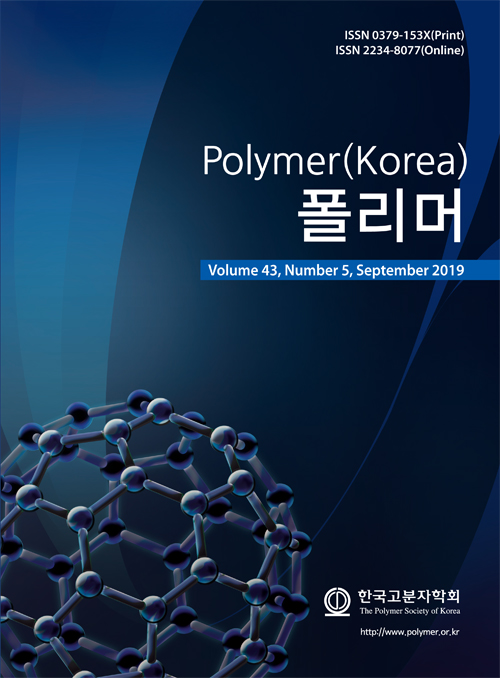Several polyaspartamide copolymers were prepared from polysuccinimide, the thermal polycondensation product of aspartic acid, via a successive ring-opening reaction using ethanolamine and other amine nucleophiles. 1H NMR and FTIR spectroscopy were used to identify the chemical structure of the polyaspartamide copolymers. A complex gel was formed upon adding tannic acid (TA) as both a physical cross-linker and adhesive enhancer to the polymer solution at different compositions in an aqueous system. The complexation behavior was investigated and the adhesive properties of the resulting complex gels were measured and compared each other. The thermal properties of the complex gels were also investigated using thermogravimetric analysis. Strong multiple hydrogen-bonding interactions between TA and the polymer chain are considered to be responsible for the formation of these biocompatible complex gels, which have potential use as novel biocompatible adhesive materials.
몇 가지 다른 폴리아스팔트아미드 유도체를 아스팔트산의 열축합 고분자인 폴리숙신이미드의 에탄올아민과 또 다른 아민 화합물을 사용한 연속적인 개환 아미노분해 반응으로부터 제조하였다. 합성한 폴리아스팔트아미드 고분자의 화학적 구조를 NMR과 FTIR 분광기를 사용하여 확인하였다. 물리적 가교제 및 접착물성 증진제로서 탄닌산과 위에서 합성한 고분자를 수용액 상에서 여러 다른 중량비로 혼합함으로써 두 성분간의 컴플렉스 젤을 제조하였다. 이들 컴플렉스 젤 형성 거동과 제조된 젤 시료의 서로 다른 기질과 조건에 대한 접착 물성을 비교 검토하였다. 한편, 열중량분석과 FTIR을 이용하여 재료의 열분해 특성과 두 성분간의 분자간 상호작용을 고찰하였다. 성분 간 강한 수소결합에 기인한 이들 생체적합성 폴리아미노산 고분자와 탄닌산의 컴플렉스 젤은 신규 생체의료용 및 산업용 접착소재로서 응용 가능할 것으로 기대된다.
Keywords: tannic acid, complex gel, polyaspartamide, adhesive properties, hydrogen bonding
- Polymer(Korea) 폴리머
- Frequency : Bimonthly(odd)
ISSN 0379-153X(Print)
ISSN 2234-8077(Online)
Abbr. Polym. Korea - 2023 Impact Factor : 0.4
- Indexed in SCIE
 This Article
This Article
-
2019; 43(5): 705-715
Published online Sep 25, 2019
- 10.7317/pk.2019.43.5.705
- Received on Apr 23, 2019
- Revised on May 14, 2019
- Accepted on May 26, 2019
 Correspondence to
Correspondence to
- Ji-Heung Kim
-
School of Chemical Engineering, Sungkyunkwan University, Suwon 16419, Korea
- E-mail: kimjh@skku.edu










 Copyright(c) The Polymer Society of Korea. All right reserved.
Copyright(c) The Polymer Society of Korea. All right reserved.